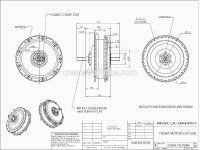Well as usual I am a little late to the party :lol: .
As far as your motor selection, IMO you made the correct choice as long as you plan to pedal some, walk the steep trails (like you said), and you don't hit any rocks or obstacles on the trail
extremely hard.
The springs in your clutch will get knocked out of place if you hammer over obstacles...happened to me riding over roots and rocks. The failure mode I experience was my clutch would not freewheel but it still transmitted power just fine. No guarantee on the failure mode others might experience.
Why you need to pedal and walk the bike up steep hills...if you push the MAC too hard, it will over heat. Set your CA to start reducing the power at about 130C and to shut down if the motor reaches 140C...those are maximums, you may want to go a little lower. The MAC can easily handle 40A/112A battery/motor current for relatively short periods of time. I have gone well beyond that just make sure your controller and your battery are capable as well.
A smaller diameter rear tire will help a little bit...it effectively gears the motor a little lower.
Batteries...you may have already decided but I like the 14s6p pack that EM3ev sells and mounting it in the triangle bag that comes with it reduces some of the shock loading as you go over bumps...I used some of the packing that came with the battery to cut and make custom pads inside the triangle bag. The triangle bag may not be feasible with your full suspension. Somebody mentioned weight distribution and I agree 100%...attempt to get everything as low as possible and have 50/50 front/rear or as close as you can get. Your bike will handle a LOT better.
If you experience a lot of overheating with your MAC...three options:
A. Add about five ounces of distilled water and Motul MoCool (at the appropriate percentage) through one of the brake rotor bolt holes...after you open the motor and remove as much of the grease as possible.
B. Add about five ounces of low visosity ATF after removing the grease as best you can.
C. Go to a BBSHD and gear it with a 28T front and a 22T rear White Industries 72 points of engagement freewheel. Your top speed with a 52v battery will be about 19-20 mph with a 27.5x3.00 Maxxis High Roller tire. The BBSHD puts out more torque with the 28/22 gearing than the MAC and doesn't over heat as easily.
If you pedal some (I did not) and walk up the steep trails...you'll probably be fine :wink: .
If you haven't put the grease on the gears yet...buy some Mobil SHC 100 and use it instead of the grease packet that EM3ev supplies. I use just enough to cover the teeth on the ring gear. The engineers at Mobil recommended it to me. If you already have your motor together it is not worth the extra effort to remove the motor and clean out the current grease...it will work just fine.
Please don't misunderstand...I am a huge MAC fan. If used appropriately...you will enjoy it and it will last a looong time

.


